The Asian food and beverage market has grown a lot in recent years. This growth offers many chances for UK entrepreneurs to start new businesses. It’s important to know the latest trends in the food and drink market in Asia.
Asian cuisine is known for its unique flavours and rich history. These aspects attract many people and create a big demand for new drinks. Businesses can tap into this demand by offering unique and innovative beverages.
Understanding the Asian Food & Beverage Market
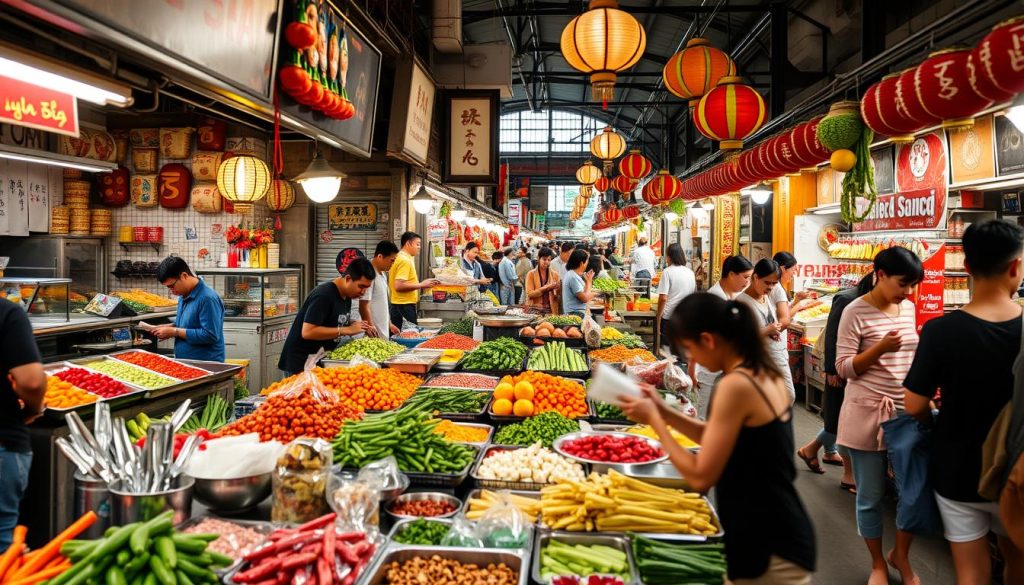
The Asian food and beverage market has seen big changes lately. Fast urban growth changes how people shop for food. More people moving to cities means they want different food choices.
As people earn more, they can pick what they eat and drink. This changes how they buy food and drinks.
People are now more interested in healthy eating. This trend pushes companies to create new, healthier products. They need to offer exciting, healthy options to meet these new demands.
Looking at the market, there are both chances and challenges. Stats from trusted sources show growth potential but also highlight competition. It’s key to understand these points to succeed in this lively market.
Growing Demand for Authentic Asian Cuisine
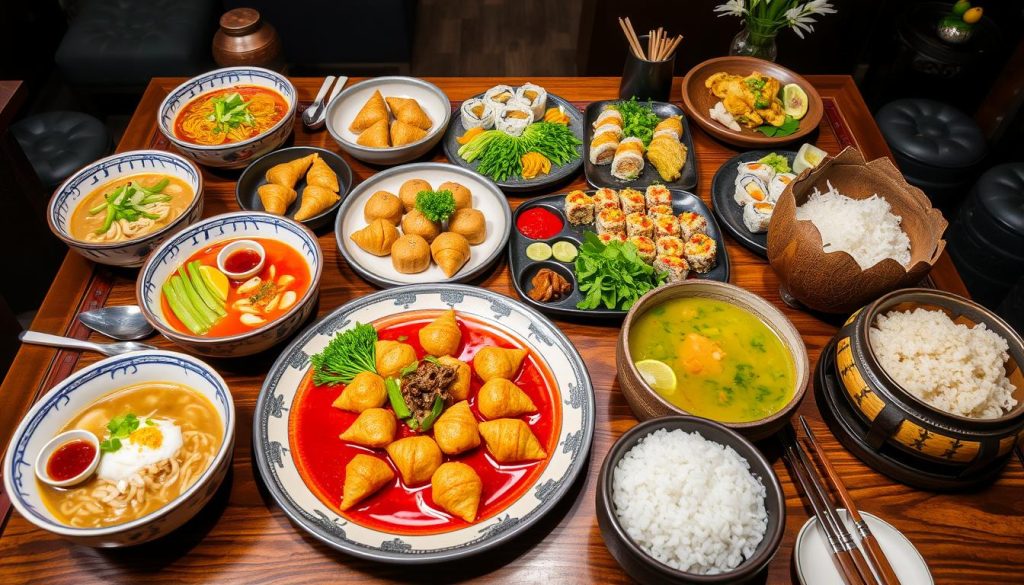
The love for authentic Asian cuisine is growing fast in the UK. People are now more interested in trying foods from around the world. This change is thanks to travel and media, which bring different tastes and cooking styles to our plates.
Chefs and restaurant owners know how key authenticity is. They stick to original recipes and methods to offer a real taste experience. This approach attracts those who want genuine flavours, not just copies.
More and more, people look for quality and realness when choosing where to eat. This search for authenticity has led to more restaurants focusing on traditional dishes. As food trends keep changing, authentic Asian cuisine remains a big hit, drawing in fans of Asian flavours.
Food and Beverage Business Ideas in Asia
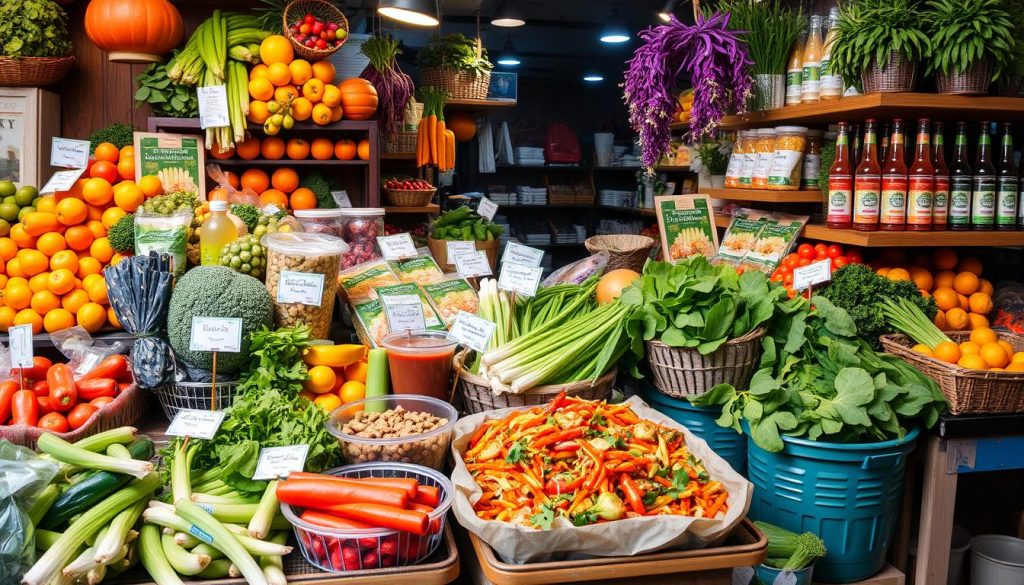
The Asian food and beverage sector is booming with new business ideas. Health-focused food trends and fusion cuisine are leading the way. As people focus more on health and sustainability, there’s a big demand for it.
Trendy Health-focused Options
Health-focused food trends are changing how we eat. They focus on organic ingredients, superfoods, and special diets. Entrepreneurs can tap into this by offering:
- Menu items with locally sourced, organic produce for health-conscious eaters.
- Superfood-packed dishes that mix Asian flavours with nutrition.
- Meal plans for specific diets, like gluten-free and vegan.
- Working with nutritionists to improve products and teach healthy eating.
Fusion Cuisine Concepts
Fusion cuisine is another exciting area for new Asian food ideas. It combines traditional Asian recipes with Western cooking styles. This trend attracts adventurous eaters and encourages creativity in the kitchen. Key strategies include:
- Creating dishes that mix flavours from different cultures, like sushi burritos or kimchi tacos.
- Adding Asian spices and cooking methods to classic Western dishes for a diverse menu.
- Starting pop-up restaurants for experimental dishes, drawing in food lovers.
- Using social media to share beautiful meals and attract customers.
Leveraging Technology for Food Delivery Services
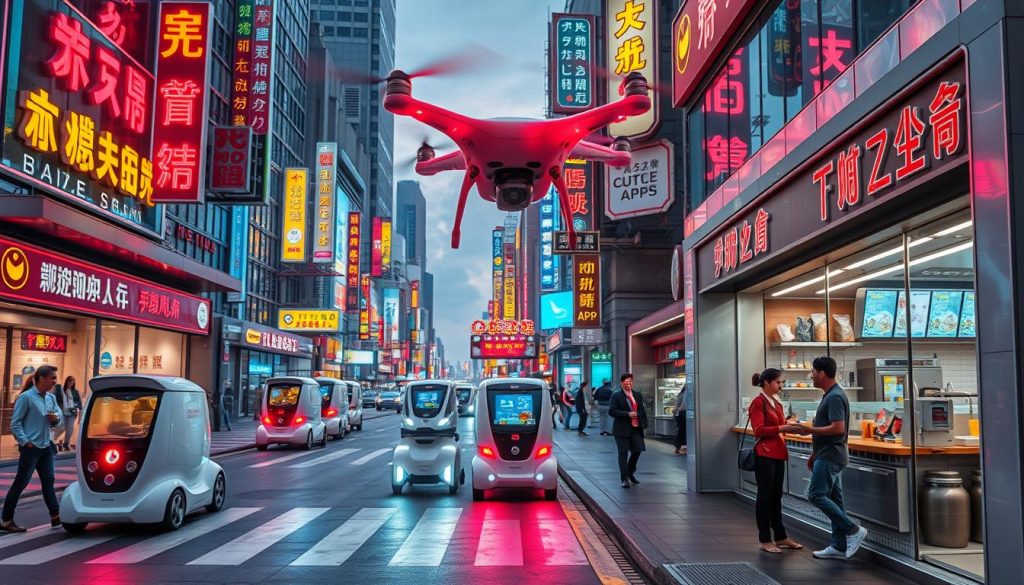
Technology has changed the food and drink world in Asia. Online ordering sites like Grab and Foodpanda have made getting food easy. Now, people can look at menus, order, and track their food on their phones.
Technology does more than just make things easy. It’s also a key marketing tool. Restaurants use data to know what customers like and improve their service. This helps them keep customers coming back.
Studies from Asia show how tech can help businesses grow. Restaurants use apps to reach more people without needing more space. This smart move helps them stand out in a crowded market.
Sustainable Practices in the Asian F&B Industry
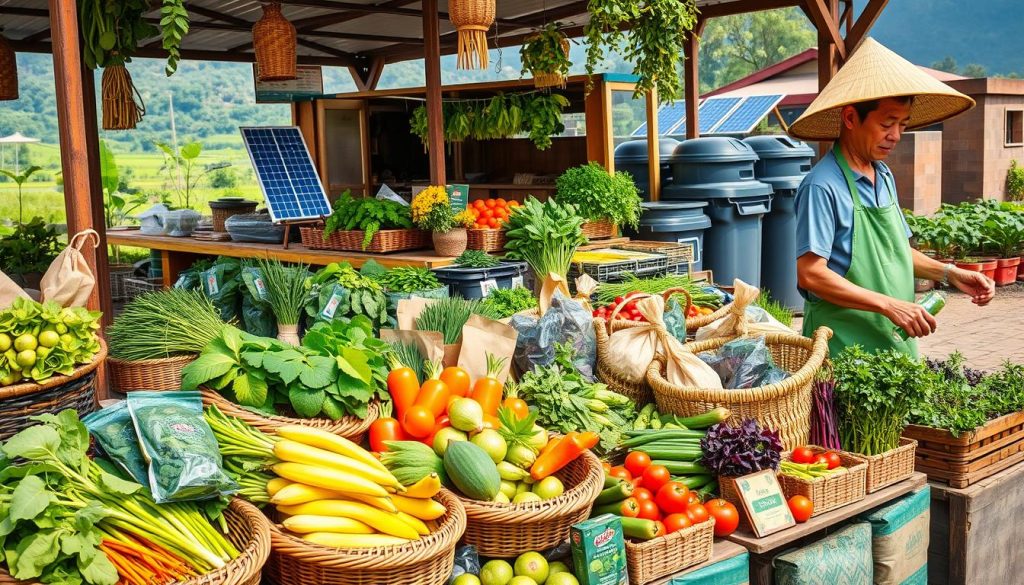
The need for sustainable food practices has grown. Many in the Asian food and beverage industry are now using new strategies. Zero-waste and local sourcing are key trends. They help reduce environmental harm and meet consumer demands for responsible practices.
Zero-Waste Initiatives
Zero-waste strategies are working well for food places. They aim to cut down on waste and use resources better. Important steps include:
- Using every part of ingredients to cut down food waste.
- Starting composting for organic waste.
- Working with local charities to give away extra food.
- Getting customers to use reusable containers for takeaways.
These efforts make a brand more appealing. They also win over customers who care about the environment.
Local Sourcing and Farm to Table
Local sourcing is becoming more popular. It’s about getting food from nearby farms. This ensures fresh produce and supports local economies. The benefits are:
- Less carbon footprint from transport.
- Seasonal menus that reflect what’s in season.
- Stronger links between people and their food.
Combining local sourcing with zero-waste efforts creates a strong sustainability plan. These practices protect the environment and build a deeper connection between people and their food.
Innovative Beverage Trends from Asia
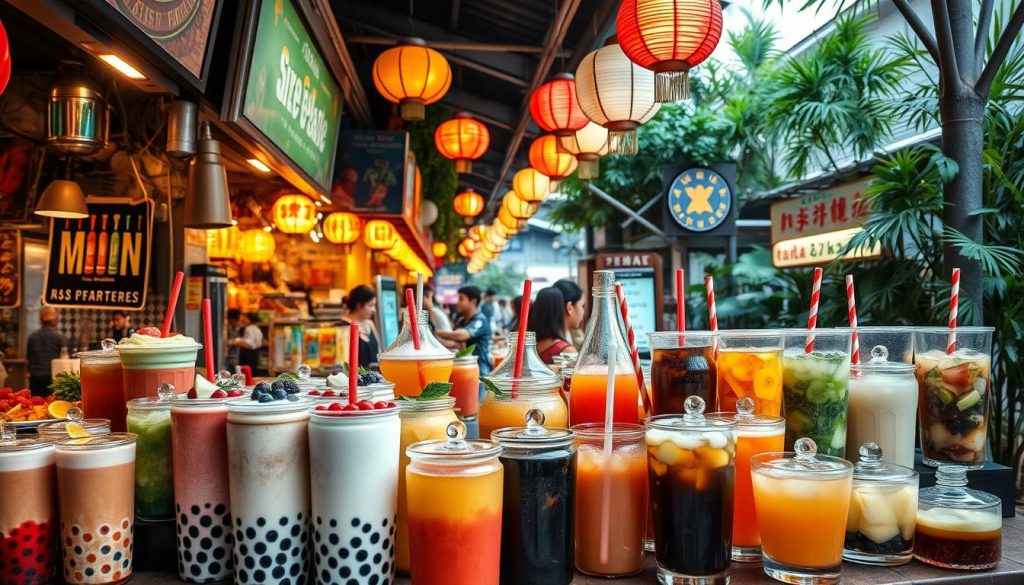
The drink scene in Asia is changing fast. New flavours and ideas are grabbing the world’s attention. Bubble tea, with its chewy tapioca pearls and exciting tastes, is leading the way. It’s opening doors to creative drinks that go beyond the usual.
Bubble Tea and Beyond
Bubble tea shows the exciting new drinks coming out of Asia. It’s all about trying new things like fruits, flowers, and even salty tastes. Also, teas with fruit and creamy drinks are becoming more popular, attracting many people.
- Unique ingredient pairings, such as matcha and taro, enhance the sensory experience.
- Innovative preparations, including layered drinks and popping boba, offer visual appeal.
- Customisation options allow consumers to tailor their beverages, increasing engagement.
These trends in Asia show a growing interest in special drinks. As people look for unique experiences, brands can explore new areas. This means endless possibilities for more exciting drinks.
The Rise of Plant-based Asian Foods

Plant-based foods are becoming more popular in Asia. Asian cuisine has always had many vegetarian dishes. But now, there’s a big increase in vegan options. This is due to health, environmental, and ethical reasons.
More people want to eat in a way that’s good for the planet and animals. Restaurants are making old dishes with plant-based ingredients. This attracts vegetarians and those who eat less meat.
- Health Benefits: Plant-based foods are often lower in calories and higher in nutrients, drawing in health-conscious diners.
- Cultural Adaptation: Traditional Asian recipes, such as mapo tofu and ramen, are being transformed to eliminate animal products.
- Market Growth: Food industry reports highlight the expanding market for vegan Asian cuisine, predicting a steady increase in sales.
Restaurateurs are using local ingredients to make tasty vegan dishes. This change makes the food scene more diverse. Now, there’s something for everyone to enjoy.
Embracing Street Food Culture

Street food trends in Asia are changing how we eat, offering a wide range of dining options. Food trucks and pop-up restaurants are at the heart of this change. They give entrepreneurs a flexible way to connect with customers. These mobile eateries are more than just food; they represent a new wave of creative cuisine.
Creative Food Truck Concepts
Food trucks have become very popular, bringing tasty dishes right to people’s doors. They often focus on specific cuisines or mix different flavours. This allows for creativity and trying new things. Entrepreneurs are using bold flavours and high-quality ingredients to make street food into gourmet meals. Some hit ideas include:
- Gourmet tacos with unique fillings, such as Korean BBQ or vegan options.
- Artisan burgers with locally sourced meats and creative toppings.
- Dessert trucks with everything from gourmet doughnuts to Asian sweets.
Pop-up Restaurant Experiences
Pop-up restaurants have become a big hit, letting chefs show off their skills in temporary spots. They often have a special theme or focus on a certain type of food. This makes for unforgettable dining experiences. Pop-up restaurants are great for trying out new ideas, like:
- Themed dining events with dishes from different Asian regions.
- Working with guest chefs to bring in new tastes and methods.
- Unique locations that add to the dining experience, like parks or cultural spots.
Exploring Niche Markets and Dietary Preferences
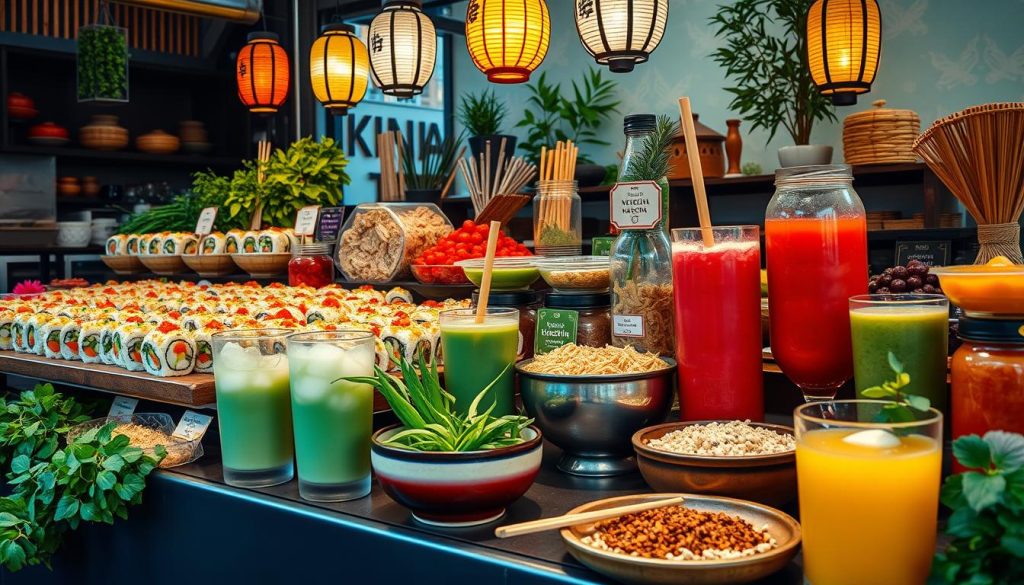
The Asian food and beverage sector is full of chances for businesses. It’s especially true for those focusing on different dietary needs. As people become more health-conscious and care about ethics, demand for halal and vegetarian food is rising. Knowing these trends is key for reaching certain groups of customers.
Halal and Vegetarian Offerings
Halal food meets the needs of many Muslim consumers. They look for genuine dining experiences. This market is promising for restaurants and food makers who value quality and authenticity.
Vegetarian options are also becoming more popular. This is because more people choose plant-based diets for health, ethical, or environmental reasons. Adding traditional Asian flavours to these dishes can make them more appealing while respecting cultural food choices.
Companies looking into these areas should study market data and consumer likes. By focusing on halal and vegetarian options, they can find their place in this expanding market. This helps in making customers happy and building brand loyalty.
Leveraging Influencer Marketing in the F&B Sector
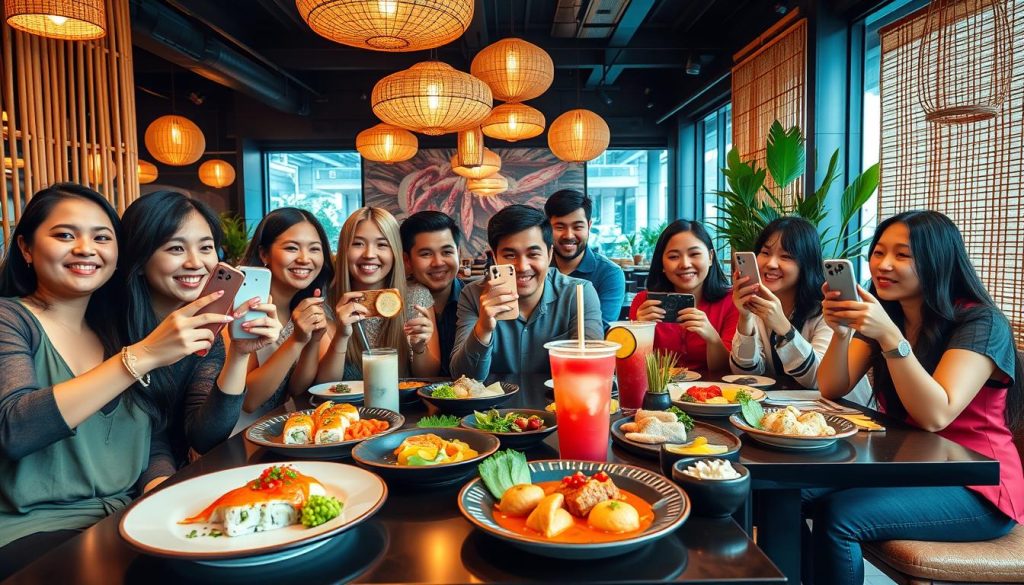
Influencer marketing is a big deal in the food and beverage world, especially in Asia. Brands see the value in working with food and beverage influencers. They help create real connections with people who might buy their products.
Using influencer marketing well means finding the right strategies. It’s about working with influencers who share your brand’s values. For example, teaming up with local food bloggers can really help a restaurant get noticed.
Social media has a huge impact on what we eat. A study found that 70% of millennials choose food based on what they see online. Working with influencers can help a brand reach more people and get them excited about new products.
- Identify suitable influencers with a strong following relevant to your market.
- Develop engaging content that showcases your products in an appealing light.
- Monitor performance metrics to assess the effectiveness of campaigns.
Adding influencer marketing to your plan can really boost your brand. It helps build loyalty and can even increase sales. This strategy is key to success in today’s fast-paced food and beverage world.
Crafting Unique Experiences for Customers

In the food business, creating a memorable experience is key. Places that focus on experiential dining see more loyal customers. They stand out from the rest. Unique dining experiences include fun activities that make meals special.
Immersive themed restaurants offer a story-filled atmosphere. Customers get to join in cooking classes, making their mealtime more engaging. This approach strengthens the bond between the customer and the brand.
Pop-up dining events are another great idea. They bring new and exciting experiences. These events feature local chefs and fresh ingredients, drawing in a wide range of people. They help spread the word about a business, which is vital in a competitive market.
- Immersive themed restaurants that incorporate storytelling.
- Interactive cooking classes that invite customer participation.
- Pop-up dining events that emphasise local culinary talent.
Brands like Dishoom and Sketch show the power of experiential dining. They turn meals into memorable experiences through art and culture. This approach creates a sense of community among their customers.
Utilizing Social Media for Business Growth
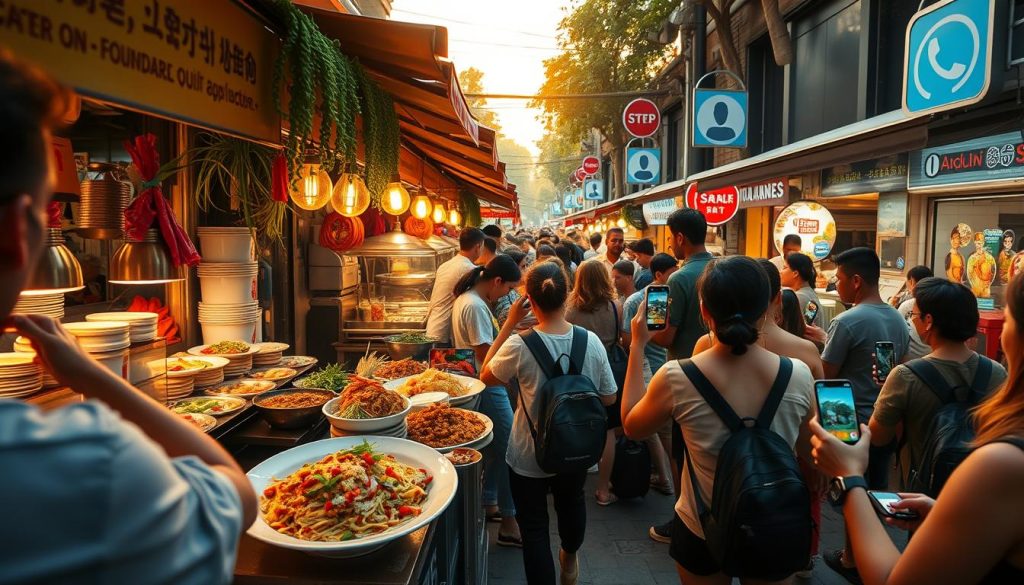
In today’s fast-paced food and beverage market, social media is key. It helps businesses grow online and reach more people. With billions of users, brands can share their stories and build loyal fans.
Good campaigns use eye-catching posts and talk to their audience. They also team up with influencers. This way, they tell their brand’s story in a way that people love. By using analytics, businesses can see what works and change their plans to stay ahead.
- Develop a consistent posting schedule to maintain visibility.
- Engage with followers through comments and interactive posts.
- Utilise video content to showcase preparation processes and customer experiences.
- Collaborate with food bloggers and influencers to expand reach.
Many brands have seen big wins with social media. For example, an Asian restaurant chain got 30% more customers after a campaign on Instagram. These stories show social media’s power in marketing.
Adapting to Local Tastes in International Markets
The food industry is changing fast, and a good international food business strategy is key. As companies grow worldwide, they must understand and adapt to local tastes. This means using local flavours and ingredients in their menus.
Brands that do this well see happy customers and loyal fans. They show they care about the local culture. This approach makes customers feel valued and keeps them coming back.
Companies going global should do lots of market research. They should talk to people in different places. This helps them know what customers like and how to make dishes better without losing their true taste.
For example, McDonald’s has made special dishes for different countries. They have the McAloo Tikki in India and the Teriyaki Burger in Japan. These dishes show how big brands can keep their identity while fitting in with local tastes.
Finding the right mix between staying true to your brand and meeting local tastes is hard. But, it’s crucial for success. Brands that focus on this can grow and stay relevant in the global market.
















